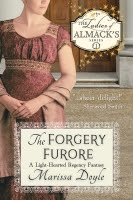 As Marissa has mentioned, ice cream was just as popular among nineteenth century ladies and gents as it is today. While few places in England get as hot as the American southwest (or my lowly abode, which saw triple digit heat the last few weeks), remember too that for most of the period there was no mechanical air conditioning or refrigeration. Overhead fans and personal fans had to be moved by hand (your servant’s or your own). If food was cooled at all, it was on ice delivered manually. And on warm summer days, there was nothing finer than scooping into a dish of icy cool ice cream.
As Marissa has mentioned, ice cream was just as popular among nineteenth century ladies and gents as it is today. While few places in England get as hot as the American southwest (or my lowly abode, which saw triple digit heat the last few weeks), remember too that for most of the period there was no mechanical air conditioning or refrigeration. Overhead fans and personal fans had to be moved by hand (your servant’s or your own). If food was cooled at all, it was on ice delivered manually. And on warm summer days, there was nothing finer than scooping into a dish of icy cool ice cream.Of course, it would have been a little difficult for these scrumptious treats to have been delivered by cart. Instead, in London, the fashionable flocked to a little confectionary shop at 7-8 Berkeley Square owned by James Gunter and his family.
Gunter’s was extremely popular for several reasons. For one thing, the food was delightful, with ices and sorbets in flavors like pistachio, pineapple, jasmine, white coffee, and elderflower. For another, it was right across the street from a park with maple trees, so you always had a place to go in the shade to eat your treat.
 But the most important reason Gunter’s was so popular was the curbside service! Gunter’s was one of the first drive up eateries. During a time when it would ruin a young lady’s reputation to be seen eating alone with a man inside a restaurant, it was perfectly acceptable to be seen eating outdoors with one! So, a gentleman would drive his carriage up under the shade of the trees across the street, and waiters from Gunter’s would dash across traffic to take his order. They’d then dash back across traffic to get the ices and return them to the gentleman and his lady. The lady would sit in the carriage and eat her treat while the gentleman generally lounged against it and chatted with her while eating his.
But the most important reason Gunter’s was so popular was the curbside service! Gunter’s was one of the first drive up eateries. During a time when it would ruin a young lady’s reputation to be seen eating alone with a man inside a restaurant, it was perfectly acceptable to be seen eating outdoors with one! So, a gentleman would drive his carriage up under the shade of the trees across the street, and waiters from Gunter’s would dash across traffic to take his order. They’d then dash back across traffic to get the ices and return them to the gentleman and his lady. The lady would sit in the carriage and eat her treat while the gentleman generally lounged against it and chatted with her while eating his. I’m sure her seat gave her quite the vantage point. After all, part of the fun of eating at Gunter’s was seeing who else was eating at Gunter’s.
Not quite the same as those ice cream trucks, huh?






 But starting in the 1840s, that began to change. Advances in the study of chemistry in the 18th and early 19th centuries led to the study of gases, among them ether and nitrous oxide. American doctors in Boston and in Georgia began experimenting with using ether during surgery, with growing success. Nitrous oxide, after some initial problems (during its first public use in a dental procedure the patient woke up too soon and began to scream) came into wide use. But it was the development and use of chloroform that really opened the field of pain control in surgery. It was developed in 1847 by a Scottish obstetrician named James Young Simpson who wanted to find an anesthetic to give women in labor. Although many doctors fought against its use because of that supposed biblical injunction, its popularity and widespread use were guaranteed after Queen Victoria chose to use it during the births of her son Leopold in 1853 and daughter Beatrice in 1857 and was vocal in its praise, even in the face of censure from Britain's premier medical journal, The Lancet. After having born seven children without the benefit of anesthesia, she knew what she was talking about!
But starting in the 1840s, that began to change. Advances in the study of chemistry in the 18th and early 19th centuries led to the study of gases, among them ether and nitrous oxide. American doctors in Boston and in Georgia began experimenting with using ether during surgery, with growing success. Nitrous oxide, after some initial problems (during its first public use in a dental procedure the patient woke up too soon and began to scream) came into wide use. But it was the development and use of chloroform that really opened the field of pain control in surgery. It was developed in 1847 by a Scottish obstetrician named James Young Simpson who wanted to find an anesthetic to give women in labor. Although many doctors fought against its use because of that supposed biblical injunction, its popularity and widespread use were guaranteed after Queen Victoria chose to use it during the births of her son Leopold in 1853 and daughter Beatrice in 1857 and was vocal in its praise, even in the face of censure from Britain's premier medical journal, The Lancet. After having born seven children without the benefit of anesthesia, she knew what she was talking about!






















